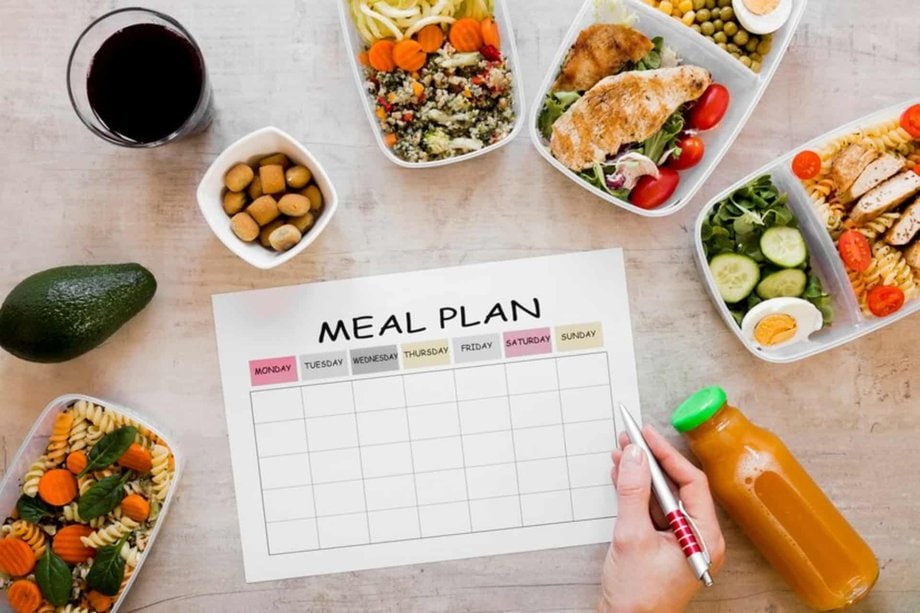How To Create A Hypertension-Friendly Meal Plan?

Hypertension, commonly known as high blood pressure, affects a significant portion of the global population and is a leading cause of cardiovascular disease. Lifestyle modifications, particularly dietary changes, are crucial in managing this condition.
This article aims to provide guidance on creating a hypertension-friendly meal plan. An understanding of the importance of a hypertension-friendly diet is essential, emphasizing the need for consultation with a healthcare professional.
By identifying nutrient-rich foods and reducing sodium intake, individuals can effectively manage their blood pressure levels. Furthermore, incorporating heart-healthy ingredients and planning balanced meals can contribute to overall cardiovascular health.
Additionally, staying hydrated and regularly monitoring and adjusting the meal plan can further optimize its efficacy. By adhering to these guidelines, individuals can develop a hypertension-friendly meal plan that supports their overall well-being and helps maintain healthy blood pressure levels.
Key Takeaways
- Include omega-3 fatty acid sources such as flaxseeds, chia seeds, walnuts, and soybean oil to help manage blood pressure.
- Incorporate low-fat dairy products or alternatives in the diet to contribute to a balanced and heart-healthy meal plan.
- Plan balanced meals with portion control, including non-starchy vegetables, lean proteins, and whole grains or starchy vegetables.
- Implement heart-healthy cooking methods, limit sodium intake, increase potassium-rich foods, and choose lean protein sources to promote optimal cardiovascular health.
Understand the Importance of a Hypertension-Friendly Diet
The significance of adopting a hypertension-friendly diet lies in its ability to effectively manage and prevent the complications associated with high blood pressure. A well-balanced meal plan can help individuals maintain healthy blood pressure levels and reduce the risk of heart disease, stroke, and other related health issues.
In addition to dietary modifications, it is crucial to incorporate regular exercise and stress management techniques into one’s lifestyle. Physical activity, such as aerobic exercises and strength training, plays a significant role in managing blood pressure by improving cardiovascular health and reducing the risk of hypertension.
Stress management techniques, such as meditation, deep breathing exercises, and mindfulness practices, can also contribute to lowering blood pressure levels. By understanding the importance of exercise and the role of stress management in conjunction with a hypertension-friendly diet, individuals can effectively control and prevent the complications of high blood pressure.
Consult with a Healthcare Professional
Consultation with a healthcare professional is essential to develop an effective approach for managing hypertension through dietary choices. Healthcare professionals, such as doctors or registered dietitians, can provide personalized guidance and consider individual factors such as medical history, current medications, and dietary preferences. They can also recommend alternative treatment options and lifestyle changes for managing hypertension.
To convey a deeper understanding, a table can be used to present the different lifestyle changes that can be made to manage hypertension. The table can include columns such as “Lifestyle Change,” “Benefits,” and “Implementation Tips.” In the “Lifestyle Change” column, examples such as adopting the DASH (Dietary Approaches to Stop Hypertension) diet, reducing sodium intake, increasing potassium-rich foods, and maintaining a healthy weight can be mentioned. The “Benefits” column can highlight the positive effects of each lifestyle change, such as lower blood pressure and reduced risk of cardiovascular diseases. The “Implementation Tips” column can provide practical suggestions for incorporating these changes into daily life, such as meal planning, reading food labels, and seeking support from family or friends.
| Lifestyle Change | Benefits | Implementation Tips |
|---|---|---|
| DASH diet | Lower blood pressure, reduced risk of heart disease | Plan meals using DASH guidelines, include fruits, vegetables, whole grains, lean proteins |
| Reduce sodium intake | Decreased fluid retention, lower blood pressure | Read food labels for sodium content, limit processed and packaged foods |
| Increase potassium-rich foods | Regulate blood pressure, support heart health | Include bananas, spinach, avocado, and sweet potatoes in meals |
| Maintain a healthy weight | Lower blood pressure, reduce strain on the heart | Engage in regular physical activity, monitor portion sizes, eat balanced meals |
Consulting with a healthcare professional ensures that individuals receive personalized guidance and support in implementing these lifestyle changes, leading to better management of hypertension.
Identify Nutrient-Rich Foods
Identifying nutrient-rich foods is crucial for effectively managing hypertension through dietary choices. Nutrient dense dishes should be incorporated into a hypertension-friendly meal plan as they provide essential vitamins, minerals, and antioxidants while minimizing the intake of sodium, saturated fats, and cholesterol.
To achieve this, meal prep techniques can be employed to ensure a balanced and varied diet. Including a wide range of fruits and vegetables, whole grains, lean proteins, and low-fat dairy products can provide the necessary nutrients for maintaining optimal blood pressure levels. Additionally, incorporating foods rich in potassium, such as bananas, spinach, and avocados, can help counteract the negative effects of sodium.
It is important to prioritize fresh, whole foods over processed options, as they are typically higher in nutrients and lower in additives and preservatives.
Reduce Sodium Intake
To effectively manage hypertension, it is crucial to reduce the intake of sodium. High sodium consumption can lead to increased blood pressure, putting individuals at a higher risk for cardiovascular diseases. When creating a hypertension-friendly meal plan, it is important to be mindful of sodium content in foods. This can be achieved by choosing fresh, whole foods and avoiding processed and packaged foods that often contain high levels of sodium.
To reduce sodium intake, individuals can opt for low-sodium alternatives or use spices and herbs to add flavor to meals instead of salt. Additionally, reading food labels and being aware of hidden sources of sodium can help in making informed choices. The table below illustrates some common high-sodium foods and their lower-sodium alternatives that can be included in meal planning:
| High-Sodium Foods | Lower-Sodium Alternatives |
|---|---|
| Canned soups | Homemade soups |
| Deli meats | Freshly cooked meats |
| Frozen dinners | Freshly prepared meals |
| Salty snacks | Fresh fruits and veggies |
By reducing sodium intake and incorporating these alternatives into meal planning, individuals can create a hypertension-friendly meal plan that promotes better blood pressure management.
Incorporate Heart-Healthy Ingredients
This discussion will focus on incorporating heart-healthy ingredients into a hypertension-friendly meal plan.
One key point to consider is the use of healthy fats, such as olive oil and avocados, which can help reduce the risk of heart disease.
Additionally, incorporating foods rich in omega-3 fatty acids, such as fatty fish like salmon and trout, can provide additional heart-healthy benefits.
Lastly, choosing low-fat dairy products, such as skim milk and Greek yogurt, can help reduce saturated fat intake and promote heart health.
Use Healthy Fats
Incorporating nutrient-rich sources of healthy fats, such as avocados, nuts, and olive oil, into a hypertension-friendly meal plan can add a flavorful and satisfying dimension to one’s diet. Healthy fats play a crucial role in maintaining heart health and managing blood pressure levels. When consumed in moderation, they can provide essential nutrients, improve satiety, and contribute to overall well-being.
Meal preparation is an excellent opportunity to incorporate healthy fats into daily meals. For instance, avocados can be mashed and spread on whole-grain toast or used as a substitute for mayonnaise in sandwiches. Nuts can be added to salads or consumed as a snack. Olive oil can be used as a dressing or for sautéing vegetables.
By incorporating these healthy fats into meal planning, individuals can enjoy a variety of delicious and heart-healthy options while managing their hypertension effectively.
Include Omega-3 Fatty Acids
Including omega-3 fatty acids in one’s diet can provide significant health benefits and contribute to the management of blood pressure levels. Omega-3 fatty acids are essential fats that play a crucial role in maintaining cardiovascular health. They have been found to reduce inflammation, lower triglyceride levels, and improve overall heart health.
There are two main types of omega-3 fatty acids: eicosapentaenoic acid (EPA) and docosahexaenoic acid (DHA). These fatty acids can be obtained from both plant and animal sources. Good sources of EPA and DHA include fatty fish such as salmon, mackerel, and sardines. For individuals who may not consume enough fish, omega-3 supplements derived from fish oil or algae can be an alternative source.
In addition to fish, plant-based sources of omega-3 fatty acids include flaxseeds, chia seeds, walnuts, and soybean oil. These foods provide alpha-linolenic acid (ALA), a type of omega-3 fatty acid that can be converted to EPA and DHA in the body, although the conversion rate is relatively low.
Incorporating omega-3 fatty acids into a hypertension-friendly meal plan can be beneficial for individuals looking to manage their blood pressure levels while enjoying a variety of nutrient-rich foods.
Choose Low-Fat Dairy Products
Consuming dairy products with reduced fat content can be a prudent choice when aiming to maintain a balanced and heart-healthy diet. Low-fat dairy alternatives, such as skim milk, low-fat yogurt, and reduced-fat cheese, provide essential nutrients without the added saturated fat and cholesterol found in full-fat dairy products. These alternatives offer a range of benefits, including lower calorie content, improved weight management, and reduced risk of cardiovascular diseases.
One crucial nutrient found in dairy products is calcium, which plays a vital role in maintaining healthy bones and teeth. Incorporating low-fat dairy into a hypertension-friendly meal plan ensures an adequate intake of calcium while minimizing the consumption of unhealthy fats. Calcium also aids in regulating blood pressure and reducing the risk of hypertension. The following table highlights the calcium content in various low-fat dairy alternatives:
| Dairy Product | Calcium Content (per 100g) |
|---|---|
| Skim Milk | 120mg |
| Low-fat Yogurt | 110mg |
| Reduced-fat Cheese | 750mg |
By choosing low-fat dairy products, individuals can enjoy the benefits of calcium while promoting heart health and managing hypertension effectively.
Plan Balanced Meals
This paragraph introduces a discussion on the subtopic of planning balanced meals.
The key points that will be discussed are:
- Portion control
- Including a variety of foods
- Opting for cooking methods that are heart-healthy
These points are important for creating a hypertension-friendly meal plan as they help to ensure that meals are:
- Properly portioned
- Contain a diverse range of nutrients
- Prepared in a way that promotes heart health.
Portion Control
Portion control plays a crucial role in designing a hypertension-friendly meal plan. By managing the amount of food consumed, individuals with hypertension can maintain a healthy weight and reduce the strain on their cardiovascular system.
When practicing portion control, it is important to consider meal preparation techniques that promote moderate serving sizes. One effective strategy is to use smaller plates and bowls, which can visually trick the mind into perceiving a larger portion. Additionally, measuring food portions with measuring cups or a food scale can provide accurate measurements and prevent overeating.
Another approach is to fill half of the plate with non-starchy vegetables, one-quarter with lean protein, and the remaining quarter with whole grains or starchy vegetables. By implementing portion control strategies, individuals can create a hypertension-friendly meal plan that supports overall cardiovascular health.
Include a Variety of Foods
Incorporating a diverse range of food choices into one’s diet is essential for promoting optimal cardiovascular health. A hypertension-friendly meal plan should include a variety of flavors and provide balanced nutrition to support overall well-being.
By including a variety of foods, individuals can enjoy different tastes and textures, making their meals more enjoyable and satisfying. Moreover, a diverse range of foods ensures a wider range of nutrients, allowing individuals to meet their nutritional needs and maintain a healthy weight.
Including fruits, vegetables, whole grains, lean proteins, and low-fat dairy products in the meal plan can provide essential vitamins, minerals, and fiber while minimizing the intake of saturated fats, cholesterol, and sodium.
By incorporating a variety of foods, individuals can create a hypertension-friendly meal plan that not only supports cardiovascular health but also contributes to a well-rounded and enjoyable eating experience.
Opt for Cooking Methods
To optimize cardiovascular health, it is advisable to select cooking methods that prioritize nutrient retention and minimize the use of unhealthy additives. Healthy cooking techniques play a crucial role in maintaining a hypertension-friendly meal plan. Steaming, grilling, and baking are recommended methods as they require little to no added fats and preserve the natural flavors of the ingredients. Steaming vegetables, for instance, helps retain their vitamins and minerals while enhancing their texture. Grilling meats allows excess fat to drip away, reducing the overall fat content. Baking is another excellent option, as it requires minimal oil and allows the food to cook in its juices. Additionally, flavorful seasoning options such as herbs, spices, and citrus juices can be used to enhance the taste without adding excessive salt or unhealthy additives. By incorporating these cooking techniques and seasoning options, individuals can create delicious and heart-healthy meals.
| Cooking Method | Advantages | Disadvantages |
|---|---|---|
| Steaming | Retains nutrients and flavors | May cause texture changes |
| Grilling | Reduces fat content | Potential formation of harmful compounds |
| Baking | Requires less oil | Longer cooking time |
| —————– | ——————– | ——————- |
Stay Hydrated
Ensuring adequate hydration is an essential aspect of maintaining a hypertension-friendly meal plan. Alongside portion control and incorporating whole grains, staying hydrated plays a crucial role in managing blood pressure. Consuming an adequate amount of water helps maintain a healthy balance of fluids in the body, promoting optimal cardiovascular function.
Moreover, hydration supports kidney function, aiding in the removal of excess sodium, a key contributor to hypertension. Additionally, staying hydrated can help prevent dehydration-induced spikes in blood pressure.
To maximize the benefits of hydration, individuals following a hypertension-friendly meal plan should aim to drink at least 8 cups (64 ounces) of water per day, unless contraindicated by a medical condition. It is important to note that beverages high in added sugars or caffeine should be limited, as they can have adverse effects on blood pressure levels.
Monitor and Adjust Your Meal Plan
Monitoring and adjusting one’s dietary regimen is crucial for maintaining optimal blood pressure levels and promoting overall cardiovascular health. To create a hypertension-friendly meal plan, it is important to follow certain meal planning tips and incorporate healthy substitutions. Here are three key strategies to consider:
- Limit sodium intake: Excessive sodium consumption can lead to high blood pressure. Be mindful of processed foods, canned soups, and fast food, as they tend to be high in sodium. Opt for fresh ingredients and season meals with herbs and spices instead.
- Increase potassium-rich foods: Potassium helps regulate blood pressure and counteracts the effects of sodium. Include foods such as bananas, leafy greens, sweet potatoes, and avocados in your meal plan to boost your potassium levels.
- Choose lean protein sources: Opt for lean meats like skinless poultry, fish, and legumes instead of high-fat meats. These protein sources are lower in saturated fats and can help maintain a healthy weight and blood pressure.
By monitoring and adjusting your meal plan with these tips and substitutions, you can take significant steps towards managing hypertension and promoting cardiovascular health.
Frequently Asked Questions
Can I still enjoy my favorite foods while following a hypertension-friendly diet?
Yes, it is possible to enjoy favorite foods while following a hypertension-friendly diet. This can be achieved by making modifications to favorite dishes, such as using healthier cooking methods and incorporating healthy substitutions for high-sodium ingredients.
How often should I consult with a healthcare professional to monitor my blood pressure and make adjustments to my meal plan?
For optimal management of blood pressure and adjustment of meal plans, it is recommended to consult with a healthcare professional regularly. The consultation frequency may vary based on individual needs and the severity of hypertension.
Are there any specific cooking techniques or methods that can help reduce sodium in my meals?
To reduce sodium intake in meals and adopt healthy cooking techniques for hypertension, individuals can use methods such as steaming, grilling, or roasting instead of frying. These techniques help retain flavor while limiting the need for added salt or high-sodium ingredients.
Is it important to consider portion sizes when planning balanced meals for hypertension?
Considering portion sizes is important when planning balanced meals for hypertension. Controlling portion sizes can help regulate calorie intake and manage blood pressure levels. It is a key aspect of maintaining a healthy diet for individuals with hypertension.
Are there any certain beverages that are particularly beneficial for maintaining a hypertension-friendly diet?
Certain beverages can be beneficial for maintaining a hypertension-friendly diet. Green tea has been shown to lower blood pressure and reduce the risk of cardiovascular disease. Hibiscus tea and beetroot juice have also demonstrated potential benefits in managing hypertension.









